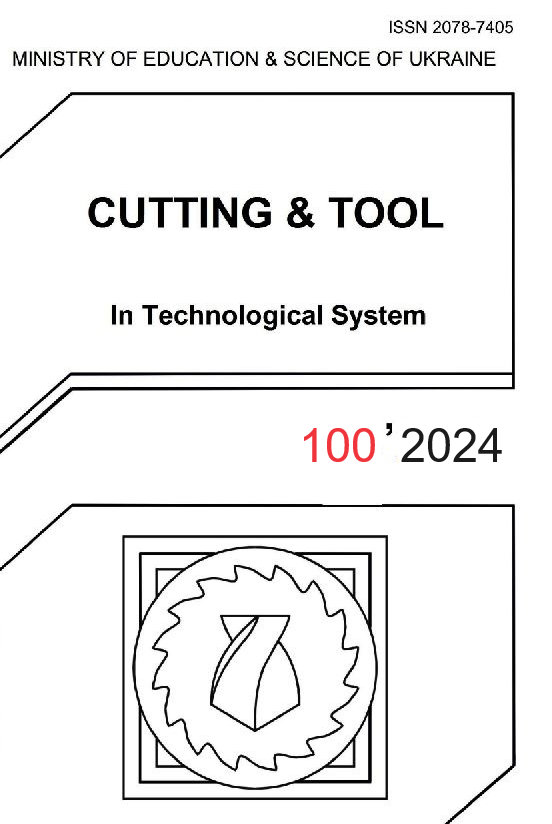LEVEREGING TECHNOLOGICAL HEREDITY TO INCREASE PRODUCTION EFFICIENCY OF FERROCERRAMIC PRODUCTS DURING FINAL MACHINING
DOI:
https://doi.org/10.20998/2078-7405.2024.100.12Keywords:
optimization, workpiece, grinding, surface quality, thermomechanical phenomena, model, defects, ; technological parameters, deviceAbstract
The quality state of grinded surface of ferro ceramic products is formed under the influence of thermomechanical phenomena which occurs during final machining and depends on the technological conditions for workpiece procurement. The mathematical model was formulated to regulate and optimize thermomechanical processes during the acquisition of ferroceramic workpieces. This mathematical model describes thermomechanical processes during workpieces sintering. Thermomechanical processes have a direct influence on defects formation in the workpieces. Grinding can cause the appearance of burns, cracks, tensile stresses in the surface layers of the products. These defects can significantly spoil the quality of products during their operation. High thermal stress of diamond-abrasive processing brings thermophysical aspects as a dominating factor for quality characteristics of processed surface. Existing grinding methods for products made from ferrocerramic materials are not able to fully eliminate the defects in the surface layer. Such defects are inherited from preceding machining operations, particularly from workpiece procurement. Material structure itself is prone or defect occurrence due to micro-heterogeneities, packaging defects, dislocations, and structural transformations. Analysis of the thermomechanical processes that run inside the surface layer made it possible to formulate calculation dependencies for defining technological conditions for eliminating burns and cracks during grinding of ferrocerramic products. Device for automatic stabilization of thermomechanical characteristics that accompany grinding of ferrocerramic products. This is achieved through the selection of optimal technological conditions for machining of the products that have heredity inhomogeneities inside the surface layer. Thus, this approach helps to achieve maximum efficiency within required quality citeria.
References
K. A. Dubrov and A. V. Usov, Opredelenije ratsionalnykh tekhnologicheskikh parametrov bezdefectnoi obrabotki ferrokerramicheskikh izdelij., in Novyje i netraditsionnyje tekhnologii v resurso-i energosberezhenii, Odessa, 2006.
K. A. Dubrov, A. V. Usov and G. A. Oborskyi, O putjah snizhenija jenergoemkosti mehanoobrabotki ferro keramicheskih materialov/, in Sovremennye problemy podgotovki proizvodstva, zagotovitel'nogo proizvodstva, obrabotki i sborki v mashinostroenii i priborostroenii, Kyiv-Svalyava, 2007.
A. V. Usov and K. A. Dubrov, Tehnologicheskie vozmozhnosti snizhenija othodov pri proizvodstve ferro keramicheskih izdelij, №. 68, pp. 342-‒350, 2005.
F. V. Novikov and V. I. Pоlyanskyi, Viznachennja umov pіdvishhennja jakostі mehanіchnoї obrobki za temperaturnim kriterіem, Perspektivnі tehnologії ta priladi, № 17, pp. 99‒105, 2020.
O. V. Yakimov, A. V. Usov, P. T. Slobodyanyuk and D. V. Iorgachev, Teplofіzika mehanіchnoї obrobki, Odessa: Astroprint, 2000, p. 256.
Y. M. Kusiy, Naukovo-prikladnі osnovi tehnologіchnogo uspadkuvannja parametrіv jakostі dlja zabezpechennja ekspluatacіjnih harakteristik virobіv. Avtoreferat disertacії na zdobuttja naukoogo stupenja dokt. tehnіch. Nauk 131 Prikladna mehanіka, Lviv, 2021, p. 44.
V. G. Lebedev, E. A. Lugovskaya and A. V. Ovcharenko, Jeksperimental'nye issledovanija processa shlifovanija martensitno-starejushhej stali N18K9M5T, Visokі tehnologії v mashinobuduvannі, vol. 1, № 27, pp. 69‒78, 2017.
V. O. Dziura and P. O. Marushak, Tehnologіchnі metodi zabezpechennja parametrіv jakostі poverhon' tіl obertannja ta їh profіlometrichnij kontrol', Ternopil: Palayanytsya, 2021, p. 170.
Nоvikоv F., Optimisation of interrupted grinding parameters according to the temperature criterion, “Cutting & Tools in Technological System”, no. 98, pp. 59‒72, 2023. https://doi.org/10.20998/2078-7405.2023.98.06
S. Malkin and C. Guo, Grinding Technology: Theory and Application of Machining with Abrasives, 2nd ed. New York, NY, USA: Industrial Press, 2008.
A. Leblond and P. Hild, Mechanics of Materials and Structures: Thermomechanics, 1st ed. Cham, Switzerland: Springer, 2019.
F. P. Vasiljev, Chislennye metody reshenija jekstremal'nyh zadach., Kyiv: Naukova dumka, 2009, p. 256.
B. D. Reddy, Thermomechanics of Solids: A Dynamical Systems Approach, Computational Mechanics, vol. 54, no. 3, pp. 567‒587, 2014.
R. B. Hetnarski and M. R. Eslami, Thermal Stresses: Advanced Theory and Applications, 2nd ed. Dordrecht, Netherlands: Springer, 2009.
S. N. Atluri and A. M. Rajendran, Modeling and Analysis of Thermal Stresses in Structures, Computational Mechanics, vol. 54, no. 4, pp. 827‒841, 2014.
G. A. Oborskyi, A. F. Dashenko, A. V. Usov and D. V. Dmytryshyn, Modelirovanie sistem, Odessa: Astroprint, 2013, p. 664.
Y. Aoyama, S. Morimoto, and Y. Yamada, Analysis of Grinding Surface Residual Stress and Subsurface Cracks in Magnetic Alloys, Journal of Materials Processing Technology, vol. 209, № 7, pp. 3478‒3485, 2009.
V. I. Pokhmurskyi and Y. I. Kryzhanovskyi, Mehanіka rujnuvannja і mіcnіst' materіalіv, Lviv-Ivano-Frankivsk, 2006, p. 1193.
A. V. Yakimov, Modelirovanie termomehanicheskih processov pri shlifovanii neodnorodnyh materialov, in Teplofizika tehnologicheskih processov, Kyiv, 2008.
Downloads
Published
Issue
Section
License
Copyright Notice
Authors who publish with this Collection agree to the following terms:
1. Authors retain copyright and grant the Collection right of first publication with the work simultaneously licensed under a Creative Commons Attribution License that allows others to share the work with an acknowledgement of the work's authorship and initial publication in this Collection.
2. Authors are able to enter into separate, additional contractual arrangements for the non-exclusive distribution of the Collection's published version of the work (e.g., post it to an institutional repository or publish it in a book), with an acknowledgement of its initial publication in this Collection.
3. Authors are permitted and encouraged to post their work online (e.g., in institutional repositories or on their website) prior to and during the submission process, as it can lead to productive exchanges, as well as earlier and greater citation of published work.

